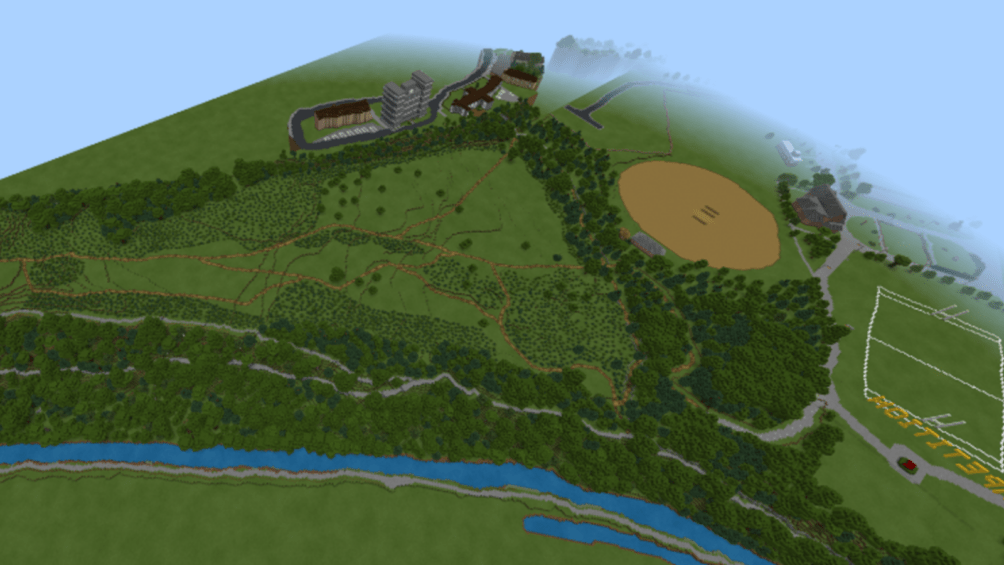We are working on an exciting partnership with Velindre University NHS Trust to adopt gamification to engage the children and young people of south east Wales in the design of the Trust’s new cancer centre.
An amazing bespoke Minecraft world encompassing the site for the new Velindre Cancer Centre has been built by our Cardiff ambassadors.
Those entering the competition will be able to explore the site and construct a Minecraft cancer centre including entrance hall on the grounds allocated to the new build. They can also propose ideas for the community space on the site which will provide enhanced outdoor space available for public use once the development is complete.
The competition is open to children and young people aged 8 to 18 and runs until 11 June. It provides those getting involved with the opportunity to explore the site and not only construct the outside of the new cancer centre and its entrance hall, but also to showcase their ideas for what can be included in the enhanced community space.
The bespoke world will include non-playing-characters and blackboards that will provide students with key information about the site and design requirements, including keeping the cancer centre within 40% of the site. The blackboards will also share statistics around cancer such as by 2030, there will be 230,000 people living with cancer in Wales to help educate young people on how cancer can impact on lives of others.
The Trust will be offering the shortlisted students the opportunity to become youth design ambassadors within the new cancer centre project so that they are able to add their voice to the design process over the course of the next year.
Carl James, Director of Strategic Transformation, Planning and Digital for Velindre University NHS Trust said, “We are excited to be launching this Minecraft for Education competition and seeing the ideas of children and young people across the region. Their input will be play an influential role in designing the new Velindre Cancer Centre.
“As a Trust, bringing in the voices of young people is important in helping us to better understand how we can work with people to improve health, well-being and health services. The Minecraft project is exciting as it will assist us in designing a cancer centre will compare favourably with others around the world and also help us provide learning and education about healthy living’.
“The Minecraft worlds we receive will be reviewed and shortlisted before feeding into the competitive dialogue process that will take place over the next year. Pupils and students who submit outstanding ideas will be offered the opportunity to join the team as youth design ambassadors and will be invited to share their further ideas and views for the new Velindre Cancer Centre, and the communities use of the facilities with the Trust, architects and a range of other people involved in the work.”
Dr Catherine Teehan, Academic Lead at our Cardiff hub commented, “We were interested in being a part of the project as we recognised that Minecraft for Education could be used to educate and engage the community with cancer care services in Wales.
“Minecraft for Education is a powerful tool to encourage children and young people to engage with technology in an inspiring way and share their ideas.”
As part of the competition, the primary and secondary schools involved will also receive an interactive and educational workbook for students that sits alongside the Minecraft world. Within the workbook, students will cover biodiversity, community and eco-buildings as key topics.
The bespoke world was developed by our ambassadors, including Laura Choy, who added, “Minecraft was a game I spent lots of time playing when I was a teenager, and I am very familiar with what it can do. When our organisation was approached by Velindre to use Minecraft as an educational package, I was selected to be the project’s manager and oversee the production of the bespoke Velindre world.
“We were given a topological diagram of the area and I formatted it so that we could turn it into a 3D model in Minecraft. We then organised five teams of ambassadors to help construct the world from the ground up. The original world was a flat surface so everything in the world was generated or placed by someone working on the project. Overall, it took around two months with student ambassadors working an average total of 10 hours per day to complete the world.”
Students will be able to register for the competition independently, but the competition will also be open for classroom teams to also enter their world(s).
